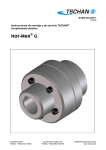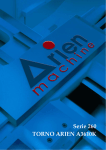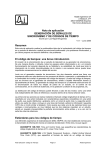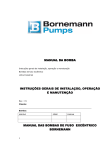Download Assembly and Service Manual Barrel Coupling
Transcript
Barrel Coupling R BAWG007-GBR-0 Assembly and Service Manual 1 INITIAL CONSIDERATIONS -The TSCHAN barrel coupling is supplied as a whole unit, ready to be mounted, but not provided with lubricant. Therefore, before it is put into service it must be lubricated in the required quantity with the appropriate lubricant, as indicated in chapter 4, table 3. - In case it is necessary to dismantle the coupling (i.e. for the machining of a pilot bored hub or for the shrink fit setting-up) it is very important to make sure that when assembling it again the hub and the sleeve-flange pair off without taking place a possible mixture between different unities and it will also have to be done in the same relative position at is was supplied. This is achieved by making coincide the marked tooth of the hub with the corresponding marked tooth of the sleeve-flange ( reference fig. 1 and 2). - The bearing-support of the drum at the opposite side of the coupling must absorb the axial forces generated during the service and must convey them to the structure. The axial component of any structural distortion must not exceed the maximum acceptable axial displacement for the coupling indicated on table no. 1. - Fixing screws for the assembly of the coupling to the drum and the securing of covers, must have a minimum 8.8 quality. The tightening torque of these screws will have to be in accordance with the said quality and also- with the material of the covers and of the drum flange. See values on table no. 2. 1. 2. 3. 4. 5. 6. 7. 8. 9. 10. 11. 12. 13. 14. 15. 16. Hub Sleeve flange Barrel External cover Pointer Internal cover Seal Retaining ring Carrier face Wear marks Axial adjustment mark Assembly mark Lubricant filler Overflow hole Extractor hole Fixing screw fig. 1 Size ± mm 25 3 50 3 75 4 100 4 130 4 160 4 Max. axial displacement 200 300 400 600 4 4 4 6 1000 6 1500 6 2600 6 3400 8 4200 8 6200 8 Table no. 1 Screw quality 8.8 Torque [Nm] Tightening torque M8 M10 M12 26 50 90 M16 215 M20 420 M24 725 Table no. 2 TK-gb-05-00.doc Tschan GmbH Zweibrücker Straße 104 - page 1 of 4 D-66538 Neunkirchen / Saar Postfach 2166 D-66521 Neunkirchen / Saar 2 SETTING UP ON THE REDUCER SHAFT HUB-SHAFT CONNECTIONS BY MEANS OF KEYS; SPLINES; ETC: -Clean the surfaces of the hub-bore and the shaft. -Pre-heat the whole coupling by putting it into a bath of hot oil at a temperature which does not exceed 80ºC so that the seals are not damaged. The oil of bath must not attack those components manufactured on a nitrile base. - Mount the hub on the shaft avoiding to bump it and applying force only to hub item 1. - Check the free axial displacement of the sleeve-flange. HUB-SHAFT CONNECTION BY MEANS OF INTERFERENCE WITHOUT KEYS In this case it is necessary to separate the hub from the rest of the coupling. - Unfasten and take away the external cover as well as the sleeve-flange, the external retainer ring and the barrels. - Clean the surfaces of the hub and the shaft. - Place the external cover together with its joint and the retainer ring over the shaft. Make sure that the space between the cover and the reducer is sufficient to house the fixing screws. If it was not so, the screws have to be previously housed in the cover. - Heat the hub up to the appropriate temperature for its mounting. Whatever method of heating is used, it must be progressive along the whole surface, preventing any localized heating spots. As an indication, a maximum temperature of 200ºC is usually enough for this operation. - Mount the hub on the shaft until reaching a reference-mark previously set or until the hub face matches the shaft end. At this stage it is crucial to avoid any contact of the hot hub with the seal. Before continuing with the procedure, wait until the hub cools down and reaches room temperature. - Set-up the sleeve-flange over the hub, checking that the matching and the position reference of these ones is the correct one. (fig. 2). - House the barrels in their cavities and place the external retainer ring in its channel. - Fix the external cover making the pointer coincide with the marks over the hub. - Check the free axial displacement of the sleeve-flange. fig. 2 TK-gb-05-00.doc Tschan GmbH Zweibrücker Straße 104 - page 2 of 4 D-66538 Neunkirchen / Saar Postfach 2166 D-66521 Neunkirchen / Saar 3 AXIAL ADJUSTEMENT AND ALIGNMENT Once the coupling has been fixed to the drum flange, its correct axial position is indicated by the coincidence of the mark at the pointer with the mark of the hub (fig. 3). At the position the setting of the opposite bearing support of the drum to the base is defined. Afterwards, the angle alignment is checked by measuring the gap „X“, (fig. 4) at four points with a separation of 90º by using a reference ruler. As an indication, the following maximum difference between the 4 measurements to the height of the external part of the sleeve-flange can be considered as acceptable: 0.3 mm for sizes ≤ TK-600 0.6 mm for sizes ≥ TK-1000 fig. 3 4 fig. 4 LUBRICATION Once the setting-up has been done and before the putting into service, the internal chamber has to be filled with lubricant EP2 (Extreme Pressure additive and consistency NLGI=2). The inlet at the external cover is suitable for placing a tubular extension up to the external part of the drum, making access easier. In practice, lubricant must be fed until it comes out of the oil overflow hole at the opposite part of the hub. As an indication, Table no. 3 shows the approximate amount depending on the different sizes. Table no. 4 shows certain references of appropriate lubricants for temperatures of -20 and up to 80°C. Please ask for advice if temperatures are out of that range. Size kg 25 0.08 50 0.10 75 0.12 100 0.14 130 0.15 160 0.17 200 0.19 300 0.23 400 0.45 600 0.57 1000 0.65 1500 0.72 2600 0.9 3400 1.0 4200 1.3 6200 2.0 Table no. 3 Reference CENTOPLEX 2 EP VERKOL EP -2 AGUILA Nr 850 EP-2 BP Energrease LS-EP 2 SHELL alvania EP-2 MOBILUX EP2 BEACON EP2 Greases (-20 °C - +80°C) Producer KLÜBER LUBRICATION VERKOL, S.A. BRUGAROLAS BP SHELL MOBIL ESSO Table no. 4 TK-gb-05-00.doc Tschan GmbH Zweibrücker Straße 104 - page 3 of 4 D-66538 Neunkirchen / Saar Postfach 2166 D-66521 Neunkirchen / Saar 5 MAINTENANCE LUBRICATION PERIODICITY Depending on the operating conditions the lubricant must be completly renewed every 2000 up to 3000 hours of operation and as a minimum, once a year. For ist renewal, feed the lubricant through the inlet, ejecting the used lubricant through the overflow hole. When new lubricant starts being ejected out of this overflow hole it will mean that the operation has been completed. PERIODICAL INSPECTIONS At least once a year the following checkings must be carried out: - Tightening of all the screws up to the recommend values and replacement of the damaged ones. - Internal wear of the teeth. The position of the mark over the pointer in relation to the marks over the hub, (fig. 5), will be an indicator of the state of the flanks wear. When the equipment is new, the pointer mark is centered (case a). When it reaches the limit (case b) the whole coupling has to be replaced. Table no. 5 shows the maximum permissible wear values, „m/2“, for applications which imply one only sense of loading (typical case of the hoisting in cranes). With applications of reversible loading sense, the amplitude between the marks must be divided by 2. Unless it is expressly asked for, couplings are standardly supplied with the marks according to the aforementioned table and therefore, it is advisable to modify them, if the application requires so, in order to correctly asses the wear evolution. - Axial adjustement According to fig. 2. If deviation was close to the maximum acceptable value on table no. 1, the seat position of the support bearing must be readjusted. - Seals control. If any deterioration appears on the sealing lips, these must be replaced. fig. 5a Between marks O.K. Size „m/2“ [mm] 25 4 50 4 fig. 5b Wear limit 75 4 Wear control 100 130 160 200 300 400 600 1000 1500 4 6 6 6 6 6 8 8 8 2600 8 3400 4200 8 8 6200 8 Table no. 5 TK-gb-05-00.doc Tschan GmbH Zweibrücker Straße 104 - page 4 of 4 D-66538 Neunkirchen / Saar Postfach 2166 D-66521 Neunkirchen / Saar








![manual de instrucciones y ce nº serie 42[...]](http://vs1.manualzilla.com/store/data/006245767_1-c7f58b57d1ee3562d103ef3dc5a749e8-150x150.png)


